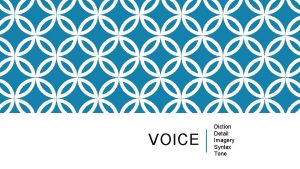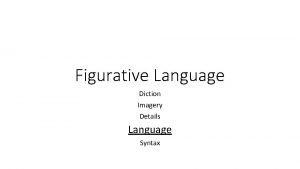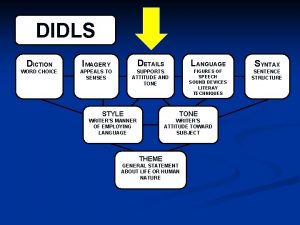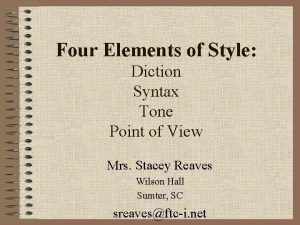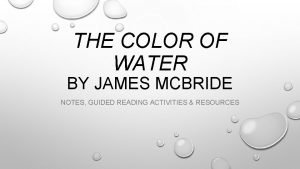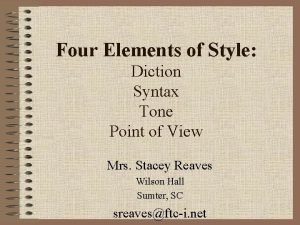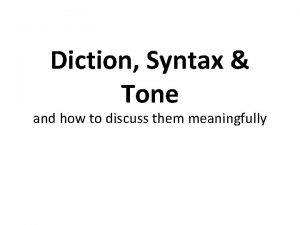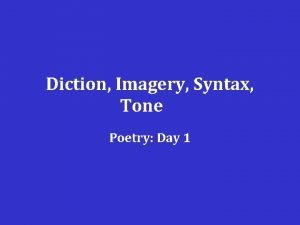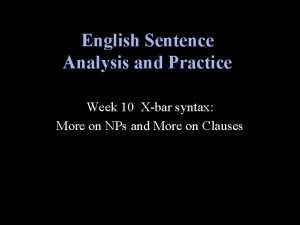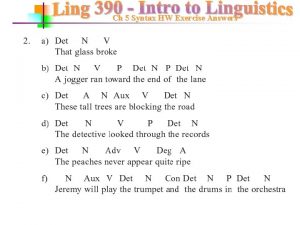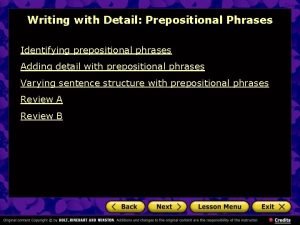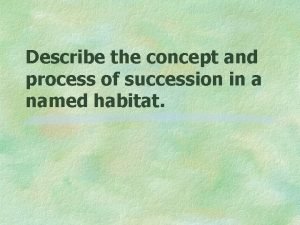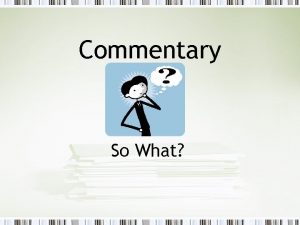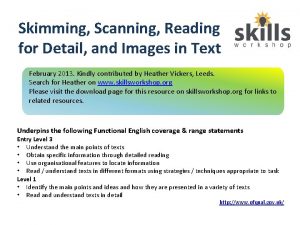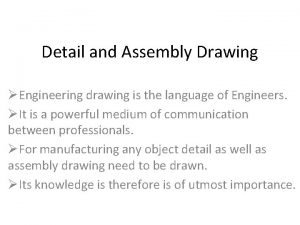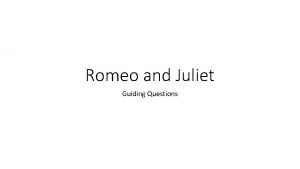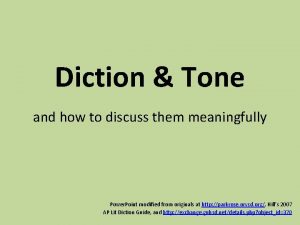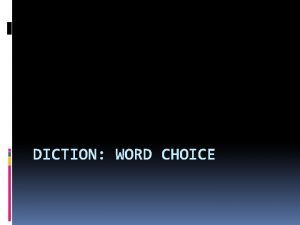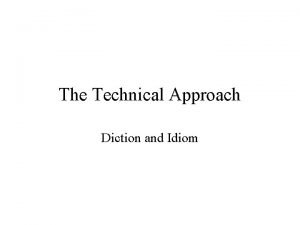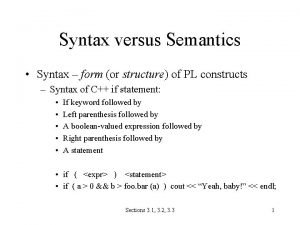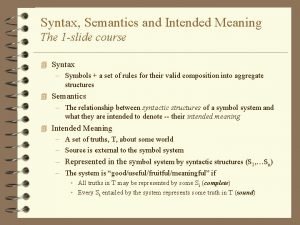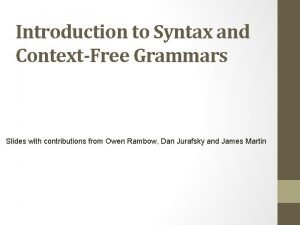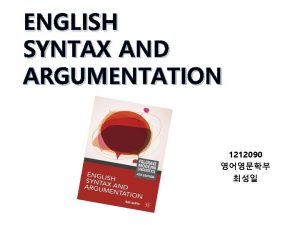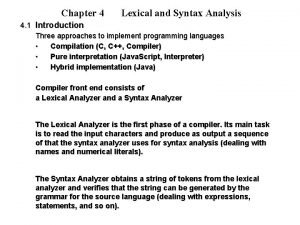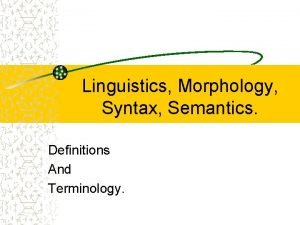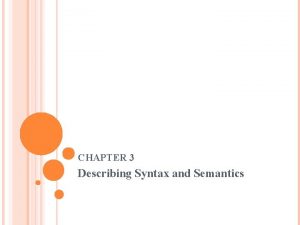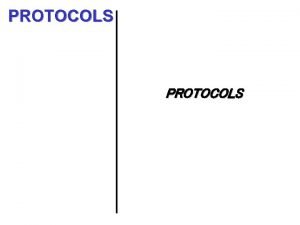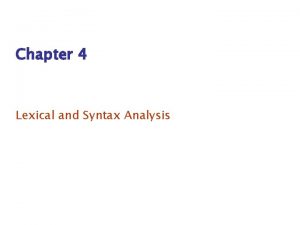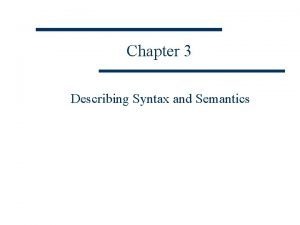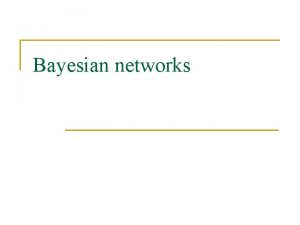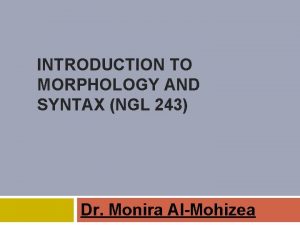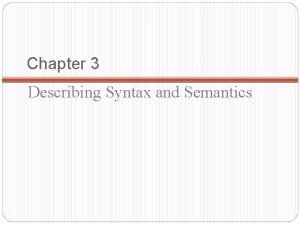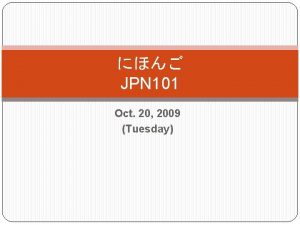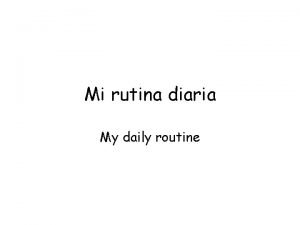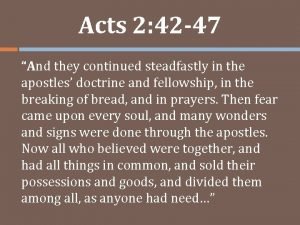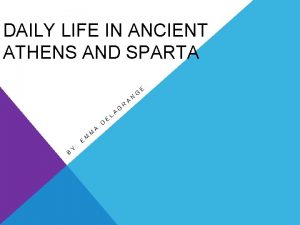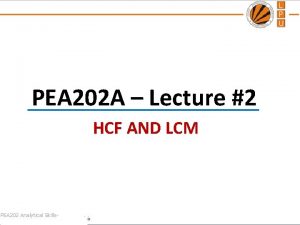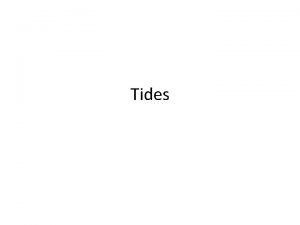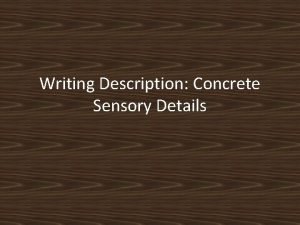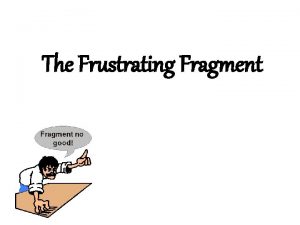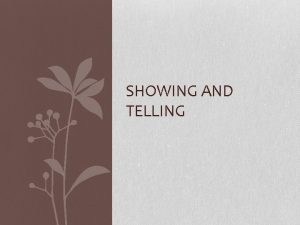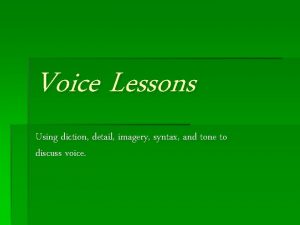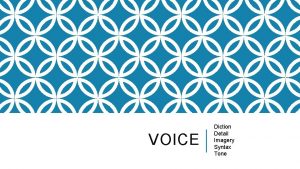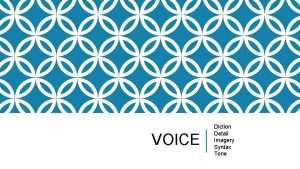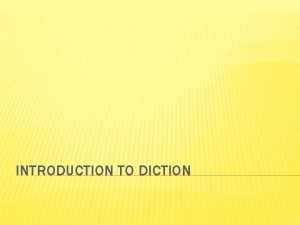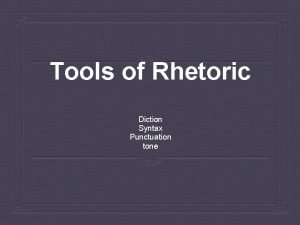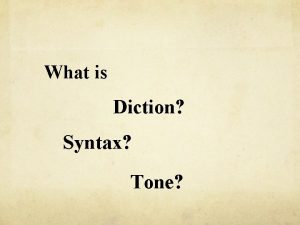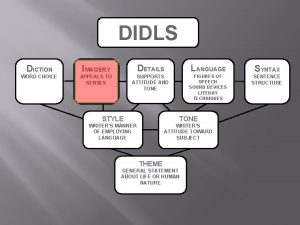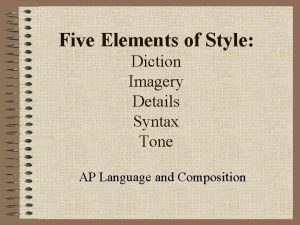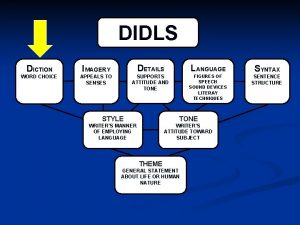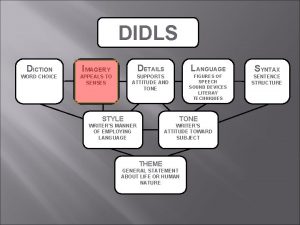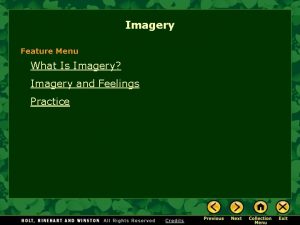Daily Exercises on Diction Detail Imagery Syntax and


















































































- Slides: 82

Daily Exercises on Diction, Detail, Imagery, Syntax, and Tone

Understanding voice in literature starts with reading. Through guided reading, you will learn to identify and appreciate the elements of voice. Understanding the elements of voice requires practice! The five elements of voice include: diction, detail, imagery, syntax, and tone

Diction (word choice) is the foundation of voice and contributes to all of its elements. Details (facts, observations, and incidents) is used to develop a topic, shaping and seasoning voice. Imagery (verbal representation of sense experience) brings the immediacy of sensory experience to writing and gives voice a distinctive quality. Syntax (grammatical sentence structure) controls verbal pacing and focus Tone (expression of attitude) gives voice its distinctive personality.

§ Imagery is the verbal representation of sensory IMAGERY experience. In literature all five senses may be represented: sight (visual imagery), sound (auditory imagery), touch (tactile imagery), taste (gustatory imagery), and smell (olfactory imagery). Visual imagery is the most common, but good writers experiment with a variety of images and even purposefully intermingle the senses (giving smells a color, for example). § Imagery depends on both diction and detail: an image’s success in producing a sensory experience results from the specificity of the author’s diction and the choice of detail. § Imagery contributes to voice by evoking vivid experience, conveying specific emotion, and suggesting a particular idea.

§ Syntax refers to the way words are arranged within sentences. Although the basic structure of the English sentence is prescribed (there must be a subject and verb; word order cannot be random), there are options in how it can be executed. § How writers control and manipulate the sentence is a strong determiner of voice and imparts personality to the writing. § Syntax encompasses word order, sentence length, sentence focus, and punctuation. There are several ways to change word order: § Inverting subject and verb (Am I ever sorry!) § Placing a complement at the beginning of a sentence (Angry, without a doubt, he was about his grade). § Placing an object in front of a verb (Sara I like—not Susan). § Good writers shift between conforming and nonconformity, preventing reader complacency without using unusual sentence structure to the point of distraction.

§ Another aspect of syntax is sentence length. Writers vary sentence length to forestall boredom and control emphasis. A short sentence following a much longer sentence shifts the reader’s attention, which emphasizes the meaning and importance of the short sentence. § Syntactic tension is the withholding of syntactic closure until the end SYNTAX of a sentence. Sentences that so delay closure are called periodic sentences. § Periodic sentences carry high tension and interest the reader must wait until the end of the sentence to understand the meaning. Ex: As long as we ignore our children and refuse to dedicate the necessary time and money to their care, we will fail to solve the problem of school violence. § Sentences that reach syntactical closure early (loose sentences) relieve tension and allow the reader to explore the rest of the sentence without urgency. Ex: We will fail to solve the problem of school violence as long as we ignore our children and refuse to dedicate the necessary time and money to their care § Repetition is another way writers achieve sentence focus. Purposeful repetition of a word, phrase, or clause emphasizes the repeated structure and focuses the reader’s attention on meaning. Writers can also repeat parallel grammatical forms such as infinitives, gerunds, and prepositional phrases.

§ Punctuation is used to reinforce meaning, construct effect, and express the writer’s voice. Of particular interest in shaping voice are the semicolon, and dash. § The semicolon gives equal weight to two or more independent clauses in a sentence. The resulting syntactical balance reinforces parallel ideas and imparts equal importance to both (or all) of the clauses. § The colon directs reader attention to the words that follow. It is also used between independent clauses if the second summarizes or explains the first. A colon sets the expectation that important, closely related information will follow , a and words after the colon are emphasized. § The dash marks a sudden change in thought or tone, sets off a brief summary, or sets off a parenthetical part of the sentence. The dash often conveys a casual tone.

Tone is the expression of attitude. It is the writer’s (or narrator’s) implied attitude toward his subject and audience. The writer creates tone by selection (diction) and arrangement (syntax) of words, and by purposeful use of details and images. Tone sets the relationship between reader and writer. Tone is the hallmark of the writer’s personality. Identifying and analyzing tone requires careful reading, sensitivity to diction and syntax, and understanding of detail selection and imagery.

Diction refers to the author’s choice of words. Words are the writer’s basic tools: they create the color and texture of the written work; they both reflect and determine the level of formality; they shape the reader’s perceptions . To understand voice, you must both “hear” the words and “feel” their effects. Solitude vs. Isolation

§ Diction depends on topic, purpose, and occasion. § The writer’s purpose—whether to convince, entertain, amuse, inform, or plead—partly determines diction. § Diction also depends on the occasion. Formal diction is largely reserved for scholarly writing and serious prose or poetry. Informal diction is the norm in expository essays, newspaper editorials, and works of fiction. Colloquial diction and slang borrow from informal speech and are typically used to create a mood or capture a particular historic or regional dialect. § When studying diction, you must understand both connotation (the meaning suggested by the word) and denotation (literal meaning). When a writer calls a character slender, the word evokes a different feeling from calling the character skinny.

(copy the information below and answer the questions in your notebook) “Art is antidote that can call us back from the edge of numbness, restoring the ability to feel for another. ” -Barbara Kingslover 1. ) By using the word antidote, what does the author imply about the inability to feel for another? 2. ) If we changed the word “antidote” to “gift”, what effect would it have on the meaning of the sentence? Brainstorm! Think of a list of medical terms. Then, write a sentence using a medical term to describe art. Be prepared to explain the effect this term has on the meaning of the sentence.


§ “As I watched, the sun broke weakly through, brightened the rich red of the fawns, and kindled their white spots, ” -E. B. White “Twins” 1. What kind of flame does kindled imply? How does this verb suit the purpose of the sentence? 2. Would the sentence be strengthened or weakened by changing the sun broke weakly through to the sun burst through? Explain the effect this change would have on the use of the verb kindled. Brainstorm! Make a list of action verbs that demonstrate the effects of sunlight.

“An aged man is but a paltry thing/ A tattered coat upon a stick…” -W. B. Yeats, “Sailing to Byzantium” 1. ) What picture is created by the use of the word “tattered”? 2. ) By understanding the connotations of the word tattered, what do we understand about the persona’s attitude towards an aged man? List three adjectives that can be used to describe a pair of shoes. Each adjective should connote a different feeling about the shoes. Be prepared to discuss your list with the class.

“The man sighed hugely” -E. Annie Proulx, The shipping News 1. ) What does it mean to “sigh hugely”? 2. ) How would the meaning of the sentence change if we rewrote it as: The man sighed loudly? Fill in the blank below with an adverb: The man coughed _________. Your adverb should make the cough express an attitude. For example, the cough could express contempt or desperation. Do not state the attitude. Instead, the let the adverb imply it.

“A rowan* like a lipsticked girl. ” -Seamus Heaney *a small deciduous tree native to Europe, having white flower clusters and orange berries. 1. ) Other than the color, what comes to mind when you think of a lipsticked girl? 2. ) How would it change the meaning and feeling of the line, if instead of lipsticked girl, the author wrote girl with lipstick on? Write a simile comparing a tree with a domesticated animal. In your simile, use a word that is normally used as a noun (like lipstick) as an adjective (like lipsticked).

§ “Abuelito under a bald light bulb, under a ceiling dusty with flies, puffs his cigar and counts money soft and wrinkled as old Kleenex. ” -Sandra Cisneros “Tepeyac” 1. ) How can a ceiling be dusty with flies? Are the flies plentiful or sparse? Active or still? Clustered or evenly distributed? 2. ) What does Cisneros mean by a bald lightbulb? What does this reveal about Abuelito’s room? Take Cisneros’s phrase, under a ceiling dusty with flies, and write a new phrase by substituting the word dusty with a different adjective.

“Meanwhile, the United States Army, thirsting for revenge, was prowling the country north and west of the Black Hills, killing Indians wherever they could be found. -Dee Brown, Bury My Heart at Wounded Knee 1. ) What are the connotations of thirsting? What feelings are evoked by this diction? 2. ) What are the connotations of prowling? What kind of animals prowl? What attitude toward the U. S. army does this diction convey? Use an eating or drinking verb in a sentence which expresses anger about a parking ticket. Do not use the verb to literally express eating or drinking. Instead, express your anger through the verb.

“Most men wear their belts low here, there being so many outstanding bellies, some big enough to have names of their own and be formally introduced. Those men don’t suck them in loose shirts; they let them hang free, they pat them, they stroke them as they stand around and talk. ” -Garrison Keillor, “Home” 1. ) What is the unusual meaning of outstanding? What is its meaning here? What does this pun reveal about the attitude of the author toward his subject? 2. ) Read the second sentence again. How would the level of formality change if we changed suck to pull and let them hang free to accept them? Write a sentence or two describing an unattractive but beloved relative. In your description, use words that describe the unattractive features honestly yet reveal that you care about this person, that you accept and even admire him/her, complete with defects.

“Doc awakened very slowly and clumsily like a fat man getting out of a swimming pool. His mind broke the surface and fell back several times. ” -John Steinbeck, Cannery Row 1. ) What is the subject of the verb broke? What does this tell you about Doc’s ability to control his thinking at this point in the story? 2. ) To what does surface refer? Remember that good writers often strive for complexity rather than simplicity. List three active verbs that could be used to complete the sentence below. HE __________ into the crowded auditorium.

“Pots rattled in the kitchen where Momma was frying corn cakes to go with vegetable soup for supper, and the homey sounds and scents cushioned me as I read of Jane Eyre in the cold English mansion of a colder English gentleman, ” -Maya Angelou, I know Why the Caged Bird Sings 1. ) By using the word cushioned, what does Angelou imply about her life and Jane Eyre’s life? 2. ) What is the difference between the cold of the English mansion and the cold of the English gentleman? What does Angelou’s diction convey about her attitude toward Jane’s life? Write a sentence using a strong verb to connect one part of your life with another. For example, you could connect a book you are reading and your mother’s dinner preparations, as Maya Angelou does; or you could connect a classroom lecture with sounds outside. Use a strong verb (like cushioned), one which connotes the attitude you want to convey.

“Once I am sure there’s nothing going on/ I step inside, letting the door thud shut. ” -Phillip Larkin, “Church Going” 1. ) What feelings are evoked by the word “thud”? 2. ) How would the meaning change if the speaker let the door “slam” shut? Write five different verbs which express the closing of a door. Next to each verb, record the feelings the word evokes.

“We have been making policy on the basis of myths, the first of them that trade with China will dulcify Peking policy. That won’t work; there was plenty of trade between North and South when our Civil War came on. ” -William F. Buckley, Jr. 1. ) What does dulcify mean? What attitude toward his readers does his diction convey? 2. ) What attitude does Buckley communicate by writing our Civil War instead of the Civil War? Rewrite the sentence below using an uncommon word for the common, boldface word. Your new words should change the connotative meaning of the sentence. She gazed at the tidy room.

“Wind rocks the car. / We sit parked by the river, / silence between our teeth. /Birds scatter across islands/ of broken ice…” -Adrienne Rich, “Like This Together, for A. H. C. ” 1. ) What are the feelings produced by the word rocks? Are the feelings gentle, violent, or both? 2. ) How would the meaning change if we changed the first line to Wind shakes the car? List different meanings for the verb rock. How many of these meanings would make sense in the poem?

“Close by the fire sat an old man whose countenance was furrowed with distress. ” -James Boswell, Boswell’s London Journal 1. ) What does the word furrowed connote about the man’s distress? 2. ) How would the impact of the sentence be changed if furrowed were changed to lined? Write a sentence using a verb to describe a facial expression. Imply through your verb choice that the expression is intense. Use Boswell’s sentence as a model.

“Her face was white and sharp and slightly gleaming in the candlelight, like bone. No hint of pink. And the hair. So fine, so pale, so much, crimped by its plaiting into springy zigzag tresses, clouding the neck and shoulders, shining metallic in the candlelight, catching a hint, if there it was, of green again, from the reflection of a large glazed cache-pot containing a vigorous sword-leafed fern. ” -A. S. Byatt, Possession: A Romance 1. ) When the author describes a face “like bone” what feelings are suggested? 2. ) How can hair be “clouding neck and shoulders”? What picture does this word create for the reader? Substitute another noun for bone in sentence one. Your substitution should change the meaning and feeling of the sentence.

“Ahh, ” the crowd went, “Ahhh, ” as the most beautiful fireworks, for the sky was alive now, one instant a pond and the next a womb of new turns: “Ahh, ” went the crowd, “Ahh!” -Norman Mailer, “Of a Fire on the Moon” 1. ) This quote is from a description of the Apollo-Saturn launching. The Saturn was a huge rocket that launched the Apollo space capsule, a three-man ship headed for the moon. Why is the sky described as a pond then a womb? Contrast the two words. What happens that changes the sky from a pond to a womb? 2. ) What does Mailer’s use of the word womb tell the reader about his attitude toward the launch?

“…Then Satan first knew pain/ And writh’d him to and fro convolv’d; so sore/ the grinding sword with discontinuous wound/ Passed through him. ” -John Milton Paradise Lost 1. ) By using the word grinding, what does Milton imply about the pain inflicted by the sword? 2. ) What does discontinuous mean? How does the idea of the use of discontinuous reinforce the idea of a grinding sword? Brainstorm! Think of contexts in which a writer might use three different kinds of swords: a grinding sword, a slashing sword, and a piercing sword.

“Newts are the most common of salamanders. Their skin is a lighted green, like water in a sunlit pond, and rows of very bright red dots line their backs. They have gills as larvae; as they grow they turn a luminescent red, lose their gills, and walk out of the water to spend a few years padding around in damp places on the forest floor. Their feet look like fingered baby hands, and they walk in the same leg patters as all four-footed creatures—dogs, mules, and, for that matter, lesser pandas. ” -Annie Dillard, Pilgrim at Tinker Creek 1. ) What is the difference between a lighted green and a light green? Which one do you think creates a more vivid picture? 2. ) What is the effect of saying fingered baby hands instead of simply baby hands? Compare the neck of each of the animals below to something familiar. The elephant’s neck looks like___________ The gazelle’s neck looks like____________ The flamingo’s neck looks like____________

“This is earthquake/ Weather!/ Honor and Hunger/ Walk lean/ together. ” --Langston Hughes, “Today” 1. ) What does “lean” mean in this context? 2. ) Is lean a verb, an adjective, or both? How does this uncertainty and complexity contribute to the impact of the lines?

“Twenty bodies were thrown out of our wagon. Then the train resumed its journey, leaving behind it a few hundred naked dead, deprived of burial, in the deep snow of a field in Poland. ” --Elie Wiesel, Night 1. ) This scene describes the transporting of Jews from Auschwitz to Buchenwald, both concentration camps in World War II. In this selection, Wiesel never refers to the men who die on the journey as men. Instead, he refers to them as bodies or simply dead. How does his diction shape the reader’s understanding of the horror? 2. ) How would the meaning change if we substituted dead people for bodies? Change the italicized word below to a word that disassociates the reader from the true action of the sentence. Fifteen chickens were slaughtered for the feast.

Detail includes facts, observations, and incidents used to develop a subject and impart voice. Specific details refer to fewer things than general descriptions, thereby creating a precise mental picture. Detail brings life and color to description, focusing the reader’s attention and bringing the reader into the scene. Because detail encourages readers to participate in the text, use of detail influences readers’ views of the topic, the setting, the narrator, and the author. Detail shapes reader attitude by focusing attention: the more specific the detail, the greater the focus on the object described.

“Whenever he was so fortunate as to have near him a hare that had been kept too long, or a meat pie made with rancid butter, he gorged himself with such violence that his veins swelled, and the moisture broke out on his forehead. ” -Thomas Babington Macaulay, “Samuel Johnson” 1. ) What effect does the detail (the spoiled hare, the rancid butter, the swollen veins, the sweaty forehead) have on the reader? 2. ) How would the meaning of the sentence be changed by ending it after himself? 3. ) Write a sentence describing someone with disgusting eating habits. IT must be one, correct sentence; and it must contain at least three vivid details.

“An old man, Don Tomasito, the baker, played the tuba. When he blew into the huge mouthpiece, his face would turn purple and his thousand wrinkles would disappear as his skin filled out. ” -Alberto Alvaro Rios, “The Iguana Killer” 1. ) The first sentence is a general statement. How does the second sentence enrich and intensify the first? 2. ) Contrast the second sentence wit the following: When he blew the tuba, his face turned purple and his cheeks puffed out. Which sentence more effectively expresses an attitude toward Tomasito? What is that attitude and how is it communicated? 3. ) Describe someone jumping over a puddle. Your first sentence should be general, stating the action simply. Your second sentence should clarify and intensify the action through detail.

Charley (to Willy): Why must everybody like you? Who liked J. P. Morgan? Was he impressive? In a Turkish bath he'd look like a butcher. But with his pockets on he was very well liked. Now listen, Willy, I know you don't like me, and nobody can say I'm in love with you, but I'll give you a job because—just for the hell of it, put it that way. Now what do you say? --Arthur Miller, Death of a Salesman 1. Who was J. P. Morgan? What is a Turkish bath? What picture comes to mind when someone is said to look like a butcher? How do these details contribute to the point Charley is trying to make? 2. How would the passage be different if Charley said J. P. Morgan would look like a baker in a Turkish bath? 3. Think of someone famous and powerful. Use detail to create an unflattering but accurate description of the physical appearance of this famous person. Model your description on Miller's description of J. P. Morgan.

To those who saw him often he seemed almost like two men: One the merry monarch of the hunt and banquet and procession, the friend of children, the patron of every kind of sport; the other the cold, acute observer of the audience chamber of the Council, watching vigilantly weighing arguments, refusing except under the stress of great events to speak his own mind. --Winston Churchill "King Henry VII" 1. Churchill draws attention to the contrasting sides of Henry VII through detail. How is the impact of this sentence strengthened by the order of the details' presentation? 2. What is Churchill's attitude toward Henry? What specific details reveal this attitude? 3. Think of someone you know who has two strong sides to his/her personality. Using Churchill's sentence as a model, write a sentence which captures—through detail—these two sides.

The truck lurched down the goat path, over the bridge and swung south toward El Puerto. I watched carefully all that we left behind. We passed Rosie's house and at the clothesline right at the edge of the cliff there was a young girl hanging out brightly colored garments. She was soon lost in the furrow of dust the truck raised. --Rudolfo Anaya, Bless Me Ultima 1. Write the words that provide specific detail and contribute to the power of the passage. 2. Contrast the third sentence with: We passed Rosie's house and saw a girl hanging out the clothes. Explain the difference in impact. 3. Rewrite the passage eliminating the specific detail. How does the elimination of the detail change the meaning of the passage?

He went on till he came to the first milestone, which stood in the bank, half-way up a steep hill. He rested his basket on top of the stone, placed his elbows on it, and gave way to do a convulsive twitch, which was worse than sob, because it was so hard and so dry. --Thomas Hardy, The Mayor of Casterbridge 1. How do the details in this passage prepare you for the convulsive twitch at the end of the passage? 2. This passage does not describe the character's face at all. What effect does this lack of detail have on the reader?

The dog stood up and growled like a lion, stiff-standing hackles, teeth uncovered as he lashed up his fury for the charge. Tea Cake split the water like an otter, opening his knife as he dived. The dog raced down the back-bone of the cow to the attack and Janie screamed and slipped far back on the tail of the cow, just out of reach of the dog's angry jaws. --Zora Neale Hurston, Their Eyes Were Watching God 1. Which details reveal that the dog has rabies? What effect do these details have on the reader? 2. Contrast the details used to describe Tea Cake (the male protagonist) and Janie (the female protagonist). What do these details reveal about the author's attitude toward these two characters? 3. Think of two contrasting characters. Write a sentence for each showing their reaction to a fight. Do not explain the different reactions; instead, show the different reactions through the use of detail.

MRS. VENABLE: … and the sand all alive, as the hatched sea-turtles made their dash for the sea, while the birds hovered and swooped to attack and hovered and—swooped to attack! They were diving down on the hatched sea-turtles, turning them over to expose their soft undersides, tearing the undersides open and rending and eating their flesh. --Tennessee Williams, Suddenly Last Summer 1. Williams use the repetition of detail in three places in the passage. Write three repeated details and decide whether the repetition enhances or detracts from the overall effect of the passage. 2. What is Mrs. Venable's attitude toward the scene she describes? Which details reveal this attitude? 3. Write a description of a sporting event. Emphasize some violent or extreme action by repeating at least two vivid details. Try to create a feeling of revulsion through your choice of details.

If my mother was in a singing mood, it wasn't so bad. She would sing about hard times, bad times, and somebody-done-gone-and-left me times. But her voice was so sweet and her singing-eyes so melty I found myself longing for those hard times, yearning to be grown without "a thin di-I-ime to my name". I looked forward to the delicious time when "my man" would leave me, when I would "hate to see that evening sun go down. . . " 'cause then I would know "my man has left this town. " Misery colored by the greens and blues in my mother's voice took all of the grief right out of the words and left me with a conviction that pain was not only endurable, it was sweet. --Toni Morrison, The Bluest Eye 1. Why are parts of the passage in quotes? What do the quoted details add to the passage? 2. Which details contribute to the conclusion that pain is sweet? Select "sweet" details and "pain" details that show Morrison sets up this oxymoron. 3. Think of a paradoxical feeling such as sweet pain, healthful illness, or frightening comfort; then make a chart listing two details for each side of the paradox.

About suffering they were never wrong, / The Old Masters: how well they understood/ Its human position; how it takes place/ While someone else is eating or opening a window or just walking dully along. --W. H. Auden, "Musee des Beaux Arts" 1. Suffering is a general term. What is a general term that sums up the detail in the last line of the stanza? 2. Compare the last line of the stanza with the phrase "While someone else is not suffering". Why is Auden's line more effective? 3. Substitute the word "laziness" for "suffering" in line of the poem. Now rewrite the last line to complete the following: While someone else is ________________________ or __________. (Your new line should give details about the opposite condition of laziness}

Under the hard, tough cloak of the struggle for existence in which money and enormous white refrigerators and shining, massive, brutally-fast cars and fine, expensive clothing had ostensibly overwhelmed the qualities of men that were good and gentle and just, there still beat a heart of kindness and patience and forgiveness. --John Okada, No-No Boy 1. What does Okada's choice of detail reveal about his attitude toward money? 2. how would the elimination of "and enormous white refrigerators and shining, massive, brutallyfast cars and fine, expensive clothing" modify the meaning and effectiveness of the sentence 3. Choose a general noun then list three concrete noun phrases that reflect your opinion of the general noun. For example, Okada uses "money" as a general noun. He then expresses his opinion of money with detailed noun phrases: "enormous white refrigerators" "shining, massive, brutally-fast cars" and "fine expensive clothing"

§ Instead of copying the voice lesson quote every day, you will now answer questions 1 -3 in complete sentences. In order to receive full credit (10 points) your answer must incorporate the question in the response. _________________ Please copy the following example in your daily folder as Voice Lesson #30 1. The narrator details the blues of the landscape and the blues of her grandmother (Abuela), What connection is revealed by this juxtaposition of images? Answer: § The juxtaposing shades of blue in the passage reveals a connection between the narrator’s perception of his aging grandmother and the changing landscape of his youth. Seating chart: Period 1 – you are now sitting in pairs! : ) Student 1: Parker Student 11: Lila Student 2: Rylee Student 12: Graham Student 3: Anajae Student 13: Hunter Student 4: Amber Student 14: Jason Student 5: Ellakyn Student 15: Andrew Student 6: Cassie Student 16: Luke Student 7: Lindsey Student 17: Wren Student 8: Emma Grace Student 18: Anne Masters Student 9: Aiden Student 19: Alex Student 10: Cole Student 20: Walt

§ Instead of copying the voice lesson quote every day, you will now answer questions 1 -3 in complete sentences. In order to receive full credit (10 points) your answer must incorporate the question in the response. _________________ Please copy the following example in your daily folder as Voice Lesson #30 1. The narrator details the blues of the landscape and the blues of her grandmother (Abuela), What connection is revealed by this juxtaposition of images? Answer: § The juxtaposing shades of blue in the passage reveals a connection between the narrator’s perception of his aging grandmother and the changing landscape of his youth. Seating chart: Period 3 – you are now sitting in pairs! : ) Student 1: Kaitlin Student 11: Carmen Student 2: Kimberly Student 12: Stacy Student 3: Dakota Student 13: Connor Student 4: Reece Student 14: Jasmine Student 5: Nicole Student 15: Kyle Student 6: Yazmine Student 16: Walt Student 7: Jacob Student 17: Student 8: Elissa Student 18: Student 9: Patrick Student 19: Student 10: Gabriel Student 20:

§ Instead of copying the voice lesson quote every day, you will now answer questions 1 -3 in complete sentences. In order to receive full credit (10 points) your answer must incorporate the question in the response. _________________ Please copy the following example in your daily folder as Voice Lesson #30 1. The narrator details the blues of the landscape and the blues of her grandmother (Abuela), What connection is revealed by this juxtaposition of images? Answer: § The juxtaposing shades of blue in the passage reveals a connection between the narrator’s perception of his aging grandmother and the changing landscape of his youth. Seating chart: Period 4 – you are now sitting in pairs! : ) Student 1: Kendal Student 11: Biscuit Student 21: Luke Student 2: Logan Student 12: Aaniyah Student 22: Chris Student 3: La’Bron Student 13: Cesar Student 23: Nathan Student 4: Sydney Student 14: Katherine Student 24: Clay Student 5: Erykah Student 15: Tawanna Student 25: Student 6: Dev Student 16: Karilla Student 7: Bobbi Student 17: Ryan Student 8: Gracie Student 18: Schuyler Student 9: Leah Student 19: Makalya Student 10: Carly Student 20: Karilla Student 26:

§ Instead of copying the voice lesson quote every day, you will now answer questions 1 -3 in complete sentences. In order to receive full credit (10 points) your answer must incorporate the question in the response. _________________ Please copy the following example in your daily folder as Voice Lesson #30 1. The narrator details the blues of the landscape and the blues of her grandmother (Abuela), What connection is revealed by this juxtaposition of images? Answer: § The juxtaposing shades of blue in the passage reveals a connection between the narrator’s perception of his aging grandmother and the changing landscape of his youth. Seating chart: Period 5 – you are now sitting in pairs! : ) Student 1: Madelyn Student 11: Alyssa Student 2: J. Strom Student 12: Lawson Student 3: Aiden Student 13: Jessica Student 4: Chloe Student 14: Lillian Student 5: Laura Student 15: Brendan Student 6: Sophie Student 16: Camille Student 7: Zion Student 17: Abi Student 8: Liam Student 18: Addie Student 9: Aubrey Student 19: Joshua Student 10: Mallory Student 20: Walt

§ Instead of copying the voice lesson quote every day, you will now answer questions 1 -3 in complete sentences. In order to receive full credit (10 points) your answer must incorporate the question in the response. _________________ Please copy the following example in your daily folder as Voice Lesson #30 1. The narrator details the blues of the landscape and the blues of her grandmother (Abuela), What connection is revealed by this juxtaposition of images? Answer: § The juxtaposing shades of blue in the passage reveals a connection between the narrator’s perception of his aging grandmother and the changing landscape of his youth. Seating chart: Period 7 – you are now sitting in pairs! : ) Student 1: Javora Student 11: Jonathan Student 2: Brenda Student 12: Lance Student 3: Nicholas Student 13: Student 4: Katelyn Student 14: Student 5: Tamiya Student 15: Student 6: Michael Student 16: Student 7: Victoria Student 17: Student 8: Deandre Student 18: Student 9: Luke Student 19: Student 10: Isabela Student 20:

Until I returned to Cuba, I never realized how many blues exist. The aquamarines near the shoreline, the azures of deeper waters, the eggshell blues beneath my grandmother's eyes, the fragile indigos tracking her hands. There's a blue, too, in the curves of the palms, and the edges of the words we speak, a blue tinge to the sand the seashells and the plump gulls on the beach. The mole by Abuela's mouth is also blue, a vanishing blue. --Cristina Garcia, Dreaming in Cuban 1. The narrator details the blues of the landscape and the blues of her grandmother (Abuela), What connection is revealed by this juxtaposition of images? 2. Why is the last blue in the passage a vanishing blue? 3. Choose a color and describe a scene using at least three varieties of that color. Try to mix details of the landscape and people.

I rounded the hut and saw a man's dead body sprawling in the mud. He was an Indian, a black Dravidian coolie almost naked, and he could not have been dead many minutes. The people said that the elephant had come suddenly upon him round the corner of the hut, caught him with its trunk, put its foot on his back and ground him to the earth. This was the rainy season and the ground was soft, and his face had scored a trench a foot deep and a couple of yards long. He was lying on his belly with arms crucified and head sharply twisted to one side. His face was coated with ud, the eyes wide open, the teeth bared and grinning with an expression of unendurable agony. --George Orwell, "Shooting an Elephant" 1. What is the author's attitude toward the coolie's death? What details in the passage reveal this attitude? 2. Examine the last sentence of this paragraph. . How would it have affected the overall impact had Orwell written, his eyes wide open, his teeth bared and grinning. . . ? 3. Think of an event you have personally witnessed which horrified you. Your job is to describe that event and evoke the horror. Do not state or explain that you were horrified. Instead, use detail to describe the event and reveal your attitude.

How fine it is to enter some old town, walled and turreted, just at approach of nightfall, or to come to some straggling village, with the lights streaming through the surrounding gloom; and then, after inquiring for the best entertainment that the place affords, to "take one's ease at one's inn!" --William Hazlitt, "On Going a Journey" 1. What details support the generalization, "how fine it is"? 2. What feelings are evoked by the details of the town (old, walled, turreted)? How does this selection of detail communicate Hazlitt's attitude toward the town? 3. Imagine going to a motel after a long day on the road. The motel is the only place to sleep in town, and the next town is 200 miles away. The motel is old and dirty; your room is shabby and dark. Write a brief passage which expresses your attitude toward this room.

She was wearing her usual at-home vesture. . It consisted mostly of a hoary midnight-blue Japanese kimono. She almost invariably wore it through the apartment during the day. With its many occultish-looking folds, it also served as the repository for the paraphernalia of a very heavy cigarette smoker and an amateur handyman; two oversized pockets had been added at the hips, and they usually contained two or three packs of cigarettes, several match folders, a screwdriver, a claw-end hammer, a Boy Scout knife that had once belong to one ofher sons, and an enamel faucet handle or two, plus an assortment of screws, nails, hinges, and ball-bearing casters—all of which tended to make Mrs. Glass chink faintly as she moved about in her large apartment. --J. D. Salinger, Franny and Zooey 1. What does the detail in the passage reveal about Mrs. Glass's character? 2. How would the fourth sentence (With its many. . . ) be different without the detail that follows the semicolon? 3. Sketch a picture of Mrs. Glass. Include in your sketch the details from the passage that you think are most expressive of the author's attitude toward Mrs. Glass.

In fact right behind her Gabriel could be seen piloting Ferddy Malins across the landing. The latter, a young man of about forty, was of Gabriel's size and build, with very round shoulders. His face was fleshy and pallid, touched with color only at the thick hanging lobes of his ears and at the wide wings of his nose. He had coarse features, a blunt nose, a convex and receding brow, tumid and protruded lips. His heavy-lidded eyes and the disorder of his scanty hair made him look sleepy. --James Joyce, "The Dead" 1. What is Joyce's attitude towards Freddy? Which specific details reveal this attitude? 2. Write a paragraph describing a character's personality by describing his/her physical traits. . Do not make any direct statements about his/her personality or character. Instead, use detail about appearance to capture character.

§ We went upstairs, through period bedrooms swathed in rose and lavender silk and vivid with new flowers, through dressing rooms and poolrooms, and bathrooms, w ith sunken baths— intruding into one chamber where a disheveled man in pajamas was doing liver exercises on the floor. --F. Scott Fitzgerald, The Great Gatsby 1. List three general adjectives that you could use to describe the house. Explain the connection between the detail in Fitzgerald's sentence and the adjectives you have chosen. 2. How does the "disheveled man in pajamas" help create the mood and atmosphere of the house? 3. Rewrite the sentence eliminating the specific detail. Discuss the change in impact and meaning.

My grandfather took me to the back of his house, to a room that my mother said was private, that she had yanked me away from when I once tried to look. It had a bead curtain at the door and we passed through it and the beads rustled like tall grass. The room was dim, lit by candles, and it smelled of incense, and my grandfather stood me before a little shirne with flowers and a smoking incense bowl and two brass candlesticks and between them a photo of a man in a Chinese mandarin hat. --Robert Olen Butler, "Mr. Green, " A Good Scent from a Strange Mountain 1. The first sentence states that the room is private. The author then uses specific detail to illustrate the privacy. How does the detail define and focus the privacy of the room. 2. Most of the passage is filled with detail describing the room. Which detail do you think adds the most to the impact of the passage? Why? 3. Write a sentence in which you use an action to characterize someone in a state of loneliness.

The wild gander leads his flock through the cool night, Ya-honk he says, and sounds it down to me like an invitation, The pert may suppose it meaningless, but I listening close, Find its purpose and place up there toward the wintry sky. The sharp-hoof'd moose of the north, the cat on the house-sill, the chickadee, the prarie-dog The litter of the grunting sow as they tug at her The brood of the turkey-hen and she with her half-spread wings, I see in them and myself the same old law --Walt Whitman, "Song of Myself" 1. What is the conclusion in the last line? Which details in the passage support this conclusion? 2. The animals in these stanzas are sspecific and detailed. In contrast, the ambience (the cool night, the wintry sky) is more general. What attitude is revealed by this difference? 3. Rewrite the passage, describing the night sky in great detail and the animals in general terms.

The day has been hot and sultry. The sun has set behind great banks of clouds which are piling up on the northwestern horizon. Now that the light is beginning to fade, the great masses of cumulus, which are slowly gathering and rising higher toward the zenith, are lit up by pale flashes of sheet-lightning. --W. J. Holland, "Sugaring for Moths" 1. What are the details that contribute to the reader's mental picture of the clouds? List these details. 2. What is sheet-lightning? Why is it more effective to say sheet-lightning than lightning? 3. Write three sentences that vividly describe a country scene. In your description, use at least two details drawn from the world of science. Use your science book if you need to.

§ “The day has been hot and sultry. The sun has set behind great banks of clouds which are piling up on the northwestern horizon. Now that the light is beginning to fade, the great masses of cumulus, which are slowly gather and rising higher toward the zenith, are lit up by pale flashes of sheet-lightning. ” --W. J. Holland, “Sugaring for Moths” 1. What are the details that contribute to the reader’s mental picture of the clouds? List these details. 2. Discuss the significance of the details in the order of their presentation. 3. What is sheet-lightning? Why is it more effective to say sheet-lightning than lighting? 4. Write three sentences that vividly describe a country scene. Remember that it is better to name a specific tree than to use the general word tree.

You will need your WRITING PORTFOLIOS And your DAILY JOURNALS IMAGERY § Imagery is the verbal representation of sensory experience. In literature all five senses may be represented: sight (visual imagery), sound (auditory imagery), touch (tactile imagery), taste (gustatory imagery), and smell (olfactory imagery). Visual imagery is the most common, but good writers experiment with a variety of images and even purposefully intermingle the senses (giving smells a color, for example). § Imagery depends on both diction and detail: an image’s success in producing a sensory experience results from the specificity of the author’s diction and the choice of detail. § Imagery contributes to voice by evoking vivid experience, conveying specific emotion, and suggesting a particular idea.

“She looked into the distance, and the old terror flamed up for an instant, then sank again. Edna heard her father’s voice and her sister Margaret’s. She heard the barking of an old dog that was chained to the sycamore tree. The spurs of the cavalry officer clanged as he walked across the porch. There was the hum of bees, and the musky odor of pinks filled the air. ” -Kate Chopin “The Awakening” 1. What are the auditory images in the passage? What mood do they create? 2. What effect does the use of an olfactory (smell) image, after a series of auditory images, have on the reader? 3. Write 3 -5 sentences in which you create a scene through auditory imagery. The purpose of your paragraph is to create a calm, peaceful mood. Use one olfactory image to enhance the mood created by the auditory imagery.

“It was a mine town, uranium most recently. Dust devils whirled sand off the mountains. Even after the heaviest of rains, the water seeped back into the ground, between stones, and the earth was parched again. ” --Linda Hogan, “Making Do” 1. What feelings do you associate with images of dusty mountains and dry earth? 2. Identify the two images associated with land compare and contrast the feelings these images evoke. 3. Write a sentence describing a rainstorm using imagery that produces a positive response; then write a sentence describing a rainstorm with imagery that produces a negative response.

A woman drew her long black hair out tight And fiddled whisper music on those strings And bats with baby faces in the violet light Whistled, and beat their wings And crawled head downward down a blackened wall And upside down in air were towers Tolling reminiscent bells, that kept the hours And voices singing out of empty cisterns and exhausted walls --T. S. Eliot “The Waste Land” 1. Paraphrase the image of the first two lines. What mood does the image create? 2. List the auditory images in these lines. How do these images help create the mood of the passage? 3. Write four lines of poetry which create—through imagery alone—a mood of absolute triumph. Do not state the nature of the triumph; do not explain or analyze. Instead, let the images create the feeling of triumph.

“In the midst of poverty and want, Felix carried with pleasure to his sister the firest little white flower that peeped out from beneath the snowy ground. ” --Mary Shelley, Frankenstein 1. What do you understand about Felix from the imagery of this sentence? 2. How would the effect be different if Felix carried his sister a big bouquet of spring flowers? 3. Write a sentence which expresses the joy of renewal through a visual image.

All the hedges are singing with yellow birds! A boy runs by with lemons in his hands. --Rita Dove, “Notes From a Tunisian Journal” 1. How does the image of the boy in the second line intensify your understanding of the hedges in the first line? 2. How would the effect be different if the second line read, “A boy runs by with apples in his hands”? 3. Write a sentence that conveys a feeling of extreme exuberance through the image of someone walking and carrying an object. Use only images, no figurative language.

This is the time of year When almost every night The frail, illegal fire balloons appear. Climbing the mountain height, Rising toward a saint Still honored in these parts, The paper chambers flush and fill with light That coms and goes, like hearts. --Elizabeth Bishop, “The Armadillo” 1. What kind of imagery does Bishop use in these two stanzas? ? 2. The image of the balloons rising and filling with light ends with a simile (like hearts). How is the effect of the simile different from that of the image? 3. Write a description of an image of an unusual sight you have witnessed on vacation. Use ten words or less. Now describe the same sight using a simile.

The egwugwu house was no ta pandemonium of quavering voices: Aru oyim de dei! Filled the air as the spirits of the ancestors, just emerged from the earth, greeted themselves in their esoteric language. --Chinua Achebe, Things Fall Apart 1. How does Achebe’s use of the Ibo language contribute to the reader’s ability to “hear” the auditory images? 2. Write a sentence about a parade. Create an auditory image by capturing sounds and actions. Use Achebe’s sentence as a model.

The rainy night had ushered in a misty morning—half frost, half drizzle—and temporary brooks crossed our path, gurgling from the uplands. -Emily Bronte, Wuthering Heights 1. Bronte uses both visual and auditory imagery in this passage. Which words create visual images? Which words create auditory images? Which words create both? 2. What feelings are traditionally associated with rain, mist, and frost? How would the feeling of this passage be different if the rainy night had ushered in a brilliant, sunny morning? 3. Write two sentences that create a mood of terror. Use visual and auditory imagery to describe the weather, thereby setting and reinforcing the mood.

Part of a moon was falling down the west, Dragging the whole sky with it to the hills. Its light poured softly in her lap. She saw it And spread her apron to it. She put out her hand Among the harp-like morning-glory strings, Taut with the dew from garden bed to eaves, As if she played unheard some tenderness That wrought on him beside her in the night. “Warren, ” she said, “he has come home to die: You needn’t be afraid he’ll leave you this time. -Robert Frost “The Death of the Hired Man” 1. 2. 3. Identify the visual, auditory, and tactile images in the lines above. How does the poet use imagery to prepare the reader for the announcement in lines 9 -10? Write a one-sentence description of some element in a garden or yard. Be certain your sentence contains a visual or tactile image.

§Write a 150 word description about a parade. In your writing, create a sense of atmosphere through auditory and visual imagery.

§ Another aspect of syntax is sentence length. Writers vary sentence length to forestall boredom and control emphasis. A short sentence following a much longer sentence shifts the reader’s attention, which emphasizes the meaning and importance of the short sentence. § Syntactic tension is the withholding of syntactic closure until the end SYNTAX of a sentence. Sentences that so delay closure are called periodic sentences. § Periodic sentences carry high tension and interest the reader must wait until the end of the sentence to understand the meaning. Ex: As long as we ignore our children and refuse to dedicate the necessary time and money to their care, we will fail to solve the problem of school violence. § Sentences that reach syntactical closure early (loose sentences) relieve tension and allow the reader to explore the rest of the sentence without urgency. Ex: We will fail to solve the problem of school violence as long as we ignore our children and refuse to dedicate the necessary time and money to their care § Repetition is another way writers achieve sentence focus. Purposeful repetition of a word, phrase, or clause emphasizes the repeated structure and focuses the reader’s attention on meaning. Writers can also repeat parallel grammatical forms such as infinitives, gerunds, and prepositional phrases.

§ Punctuation is used to reinforce meaning, construct effect, and express the writer’s voice. Of particular interest in shaping voice are the semicolon, and dash. § The semicolon gives equal weight to two or more independent clauses in a sentence. The resulting syntactical balance reinforces parallel ideas and imparts equal importance to both (or all) of the clauses. § The colon directs reader attention to the words that follow. It is also used between independent clauses if the second summarizes or explains the first. A colon sets the expectation that important, closely related information will follow , a and words after the colon are emphasized. § The dash marks a sudden change in thought or tone, sets off a brief summary, or sets off a parenthetical part of the sentence. The dash often conveys a casual tone.











Tone is the expression of attitude. It is the writer’s (or narrator’s) implied attitude toward his subject and audience. The writer creates tone by selection (diction) and arrangement (syntax) of words, and by purposeful use of details and images. Tone sets the relationship between reader and writer. Tone is the hallmark of the writer’s personality. Identifying and analyzing tone requires careful reading, sensitivity to diction and syntax, and understanding of detail selection and imagery.
 The narrator details the blues of the landscape
The narrator details the blues of the landscape An old man don tomasito
An old man don tomasito Figurative language diction
Figurative language diction Didls language
Didls language Major and minor supporting details
Major and minor supporting details Minor and major supporting details
Minor and major supporting details Sophisticated diction example
Sophisticated diction example Meter and diction
Meter and diction Pedantic diction
Pedantic diction Syntax vs diction
Syntax vs diction Levels of diction
Levels of diction Syntax and diction
Syntax and diction Diction and syntax
Diction and syntax Syntax of mkleaf is
Syntax of mkleaf is Style of diction
Style of diction Syntax versus diction
Syntax versus diction Is imagery diction
Is imagery diction The man sighed hugely
The man sighed hugely X bar theory in syntax exercises
X bar theory in syntax exercises Hw
Hw Constituency tests syntax exercises
Constituency tests syntax exercises Yule 2010
Yule 2010 Lsvt big video
Lsvt big video Identifying prepositional phrases
Identifying prepositional phrases Front end phases of compiler
Front end phases of compiler Discuss in detail the concept and process of hydrosere'
Discuss in detail the concept and process of hydrosere' Concrete and specific details
Concrete and specific details Parapet wall material
Parapet wall material Objectives of skimming
Objectives of skimming Draw a mortise and tenon joint
Draw a mortise and tenon joint Diction in romeo and juliet
Diction in romeo and juliet Diction vs tone
Diction vs tone Uses diction that captures the writer's voice
Uses diction that captures the writer's voice Hold thy desperate hand
Hold thy desperate hand Diction literary definition and example
Diction literary definition and example What is technical diction
What is technical diction Diction and register
Diction and register Semantics syntax
Semantics syntax Syntax symbols and meanings
Syntax symbols and meanings Syntax and grammar
Syntax and grammar What is syntax
What is syntax Syntax and grammar
Syntax and grammar Differences between morphology and syntax
Differences between morphology and syntax English syntax and argumentation 연습문제 답
English syntax and argumentation 연습문제 답 Lexical and syntax analysis
Lexical and syntax analysis Morphology definition linguistics examples
Morphology definition linguistics examples Lexical and syntax analysis
Lexical and syntax analysis Cs2303
Cs2303 Formal methods of describing syntax
Formal methods of describing syntax Discourse and syntax
Discourse and syntax Syntax semantics and timing
Syntax semantics and timing Syntax and semantics
Syntax and semantics Pairwise disjointness test
Pairwise disjointness test Describing syntax and semantics
Describing syntax and semantics Bayesian networks
Bayesian networks Introduction to morphology and syntax
Introduction to morphology and syntax Lexical and syntax analysis
Lexical and syntax analysis Describing syntax and semantics
Describing syntax and semantics The periodic daily rise and fall of ocean water
The periodic daily rise and fall of ocean water Organize and complete daily work activities doc
Organize and complete daily work activities doc Daily routines and adverbs of frequency
Daily routines and adverbs of frequency Daily news and analysis epaper
Daily news and analysis epaper Kenora daily miner and news
Kenora daily miner and news Infographic
Infographic Rutina desde que me levanto hasta que me acuesto
Rutina desde que me levanto hasta que me acuesto And they continued daily
And they continued daily Daily meal count and attendance record
Daily meal count and attendance record Daily life in ancient athens
Daily life in ancient athens Daily life and popular culture in the 1950s
Daily life and popular culture in the 1950s Hcf sums for class 5
Hcf sums for class 5 The periodic daily rise and fall of ocean water
The periodic daily rise and fall of ocean water Organize and complete daily work activities doc
Organize and complete daily work activities doc Da 2166
Da 2166 Adverb of detail
Adverb of detail Sensory detail definition
Sensory detail definition What is added detail fragment
What is added detail fragment Explain rmmm
Explain rmmm What is one example of a telling detail from hope
What is one example of a telling detail from hope Xoserve-detail-page-one (xoserveservices.com)
Xoserve-detail-page-one (xoserveservices.com) Tulangan pokok dan tulangan bagi
Tulangan pokok dan tulangan bagi Concrete detail sentence starters
Concrete detail sentence starters Detail oriented culture
Detail oriented culture Multi pass assembler in compiler design
Multi pass assembler in compiler design

